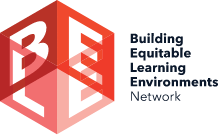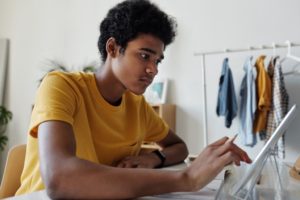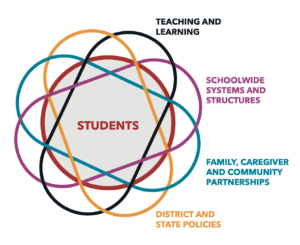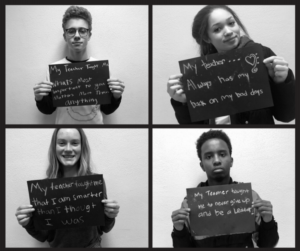[Cross-posted from the BELE Network Medium]
By Dr. Sasha Rabkin, Chief Strategy Officer, Equal Opportunity Schools
Spring is typically filled with rites of passage for high school students, from prom, to AP tests, to college acceptances and graduations. But for millions of students this year, all this was put on hold as educators rushed to scale teaching and learning in a remote, online environment amidst a global health crisis. Many schools around the country are grappling with how to locate and engage students who have gone radio silent, while others, like Paul Laurence Dunbar High School in Baltimore, have been laying the groundwork for equitable learning for a while, and are better prepared to navigate the student “visibility” crisis.
Seeing vs. Knowing
Undoubtedly, education’s preexisting condition is inequity; and if we don’t solve for it now, it may just kill us. The varied school and district responses to COVID-19 have thrown into sharp relief the depth of inequities in education — from data, to instruction, to basic access — when something as simple as not having an updated address or phone number on file for a student can mean they disengage from their education at a time when they may need more adult support, not less. Crises, as we’ve learned from countless medical reports, exacerbate pre-existing conditions.
Invisibility preconditions inequity in our education system, and the education system can only be successful when every single student is seen, empowered and supported. This has been a challenging promise to fulfill even during the best of times for students of color who have experienced decades of systemic isolation and invisibility, and it is something the education system will struggle with even more so now.
But this visibility gap goes much deeper — it’s one thing to see a student and another to know them. The initial response to this crisis from some of our partners shows that districts who have a history of prioritizing equity and student visibility, and who’ve learned to take advantage of tools and technology to beget equitable learning environments, have been more prepared to respond to this crisis. And while tools and technology are necessary, they are an insufficient answer. The powerful match of transformational leaders and the right toolbox can and will produce better outcomes for our students.
We have built the current education system on two fundamental truths: proximity and observation. We may have dressed them up with assessments, grades and standards, but at its root education is a relational experience — and it almost always happens in physical proximity. Now that these truths have been shaken, what more might we question? We’ve already seen the SATs lose their mojo, and grades appear particularly tone deaf now. What is next? Can we also start to question the biased assumptions that have helped prop up an inequitable education system and instituted barriers to equal opportunity?
The Student “Baseball Card”
For years, Equal Opportunity Schools has partnered with districts to create “Student Insight Cards” for each student. A tool our school partners affectionately call the ‘baseball card’, the Student Insight Card is a full page, easily digestible, 40+ data point illustration of student experiences and assets that goes well beyond GPA and test scores. Student Insight Cards are made in real time via an intentionally designed 20-minute survey that collates not just a student’s academic performance, but their most trusted adults at school, their dreams and aspirations, mindsets and barriers, and what kind of support they need to thrive.
This tool was designed to identify students of color and low income students who are ready right now to excel in advanced high school courses, but have been excluded — because of implicit and explicit biases, racism and gatekeeping. This tool ensures that each student is more holistically seen and known to the adults around them, and then placed in the classroom environments that will challenge them and stretch them academically — while also provoking a bit of cognitive dissonance for us as educators about all the things we think we know about students.
But these tools, like many things during a crisis, can change and adapt depending on who is wielding them. Right now, partners are innovating to use the Student Insight Cards to tackle the visibility crisis head-on. They are proving that their investment in collecting unique student data and challenging their mindsets about equity and access has paid off.
At Baltimore’s Dunbar High School, principal Dr. Yetunde Reeves has been able to ensure her students and school remain resilient during the crisis. Dunbar serves a student population that is 90% African American, with all students receiving free and/or reduced lunch. But because of Dr. Reeve’s leadership in introducing equitable tools like the Student Insight Cards, Dunbar was better prepared and better able to respond to the crisis. Dunbar deployed the trusted adults identified by each student in the EOS survey to connect with students, and staff are using Student Insight Cards to help “get to know students” in their absence, as they plan ahead for the next school year. Dunbar High School’s foundational work to integrate equity has allowed them to respond to immediate needs, while not losing sight of the need to actively plan for an equitable future for the school and students.
Countless other schools, from Oregon to New York to the California Bay Area, are using our toolbox of data and insights (as well as powerful remote professional learning) to think differently about students, equity, engagement, and the urgent need for connection, encouragement and support. Few of our school partners would say they were “ready” for this crisis, but those who embraced the realities of a deeply inequitable system, and who had been building equitable foundations prior to COVID-19, appear most resilient and able to face this current crisis head on.
Efficiency vs. Efficacy
This approach and mindset of making sure that every student feels supported and moored to their education can be replicated in a host of diverse ways, no matter where a school is located. However, we’re aware that educators and parents are currently being inundated with resources and list after list of tools that promise to help mitigate the transition to virtual learning. How can educators and administrators make sure that they’re addressing the visibility crisis in an equitable way?
There are two critical points to consider at this juncture. The first is that technology is not a panacea. It can not fix deeply embedded issues that have been caused by decades of systemic racism against Black and brown students. The second is that there’s a difference between a tool that makes processes efficient for educators and one that makes education more effective for students. The promises of the former are alluring, especially for stressed and overburdened educators who have been given a Herculean task with varying (low) levels of support. But efficiency tools can lull educators and systems into complacency. Instead, intentional data collection and tools that maximize effectiveness over efficiency are the types of short and long term investments that can bring about the equitable future we want to see. Truthfully, it will take hard work and a deep commitment, but as we’ve seen so far, preventative measures are far more impactful than reactive ones.
An Equitable Future Requires a New Normal
So where do we go from here? Never before has our education system experienced such a shock, and COVID-19 has exposed many fault lines. It’s clearer than ever that schools need to empower every student, especially Black and brown students, to not just survive this world, but reconstruct it to be wiser and more equitable so that crises like this don’t ever have the same devastating, inequitable, large-scale impact. But this can’t be done by going “back to school,” because frankly, what we had in place pre-COVID-19 wasn’t delivering on any metrics, from graduation rates, college completion, or upward economic mobility for students of color and low-income students. This can only be done by going forward to new, more equitable learning environments.
Educators and advocates are taking the time right now to respond, process and even grieve, but I hope that we can earnestly and honestly prepare for the challenges and opportunities that lie ahead. The coming years are a time to disrupt, innovate and reject the status quo that we previously thought was unshakeable. Countless people will come at us with ideas and solutions. We will have to be resolute in our insistence that the only solutions we will accept are those that prioritize the experiences, genius and talents of students of color and low income students. There will be lots of talk in the coming months about a budget crisis; but if there is money for corporations, we must also insist there is money for our children.
We’re here to partner with educators who are leaning into letting go of the comfort zone and the temptation to return to old systems and processes, because deep down, we know that there’s no such thing as “normal” post-COVID-19. Now is the time to prioritize effectiveness over efficiency, reminding ourselves that our students deserve an education system that knows them as unique individuals with hopes and dreams. Before the dust settles, we must collectively acknowledge the importance of inclusive, equitable design. As our friends at the National Equity Project recently noted, now is the time for Rebel Leadership. Schools like Dunbar in Baltimore that prioritize equity are better prepared for crises that demand responsiveness because it’s already been built into how they operate.
It won’t be an easy road, but the choices school, district, and organization leaders make now have the potential to transform the educational landscape for generations to come, so that we can finally deliver on the promises we’ve made to students.
Dr. Sasha Rabkin is the Chief Strategy Officer at Equal Opportunity Schools, a national non profit headquartered in Seattle, Washington, and dedicated to ensuring students of color and low-income students have equitable access to America’s most academically intense high school programs and succeed at the highest levels. EOS is also a partner of the BELE Network.
For more information about where EOS and all of our BELE Network partners work, visit our map. For more tools and resources on how to build equitable learning environments, visit our Equitable Learning Library.






Leave a Reply